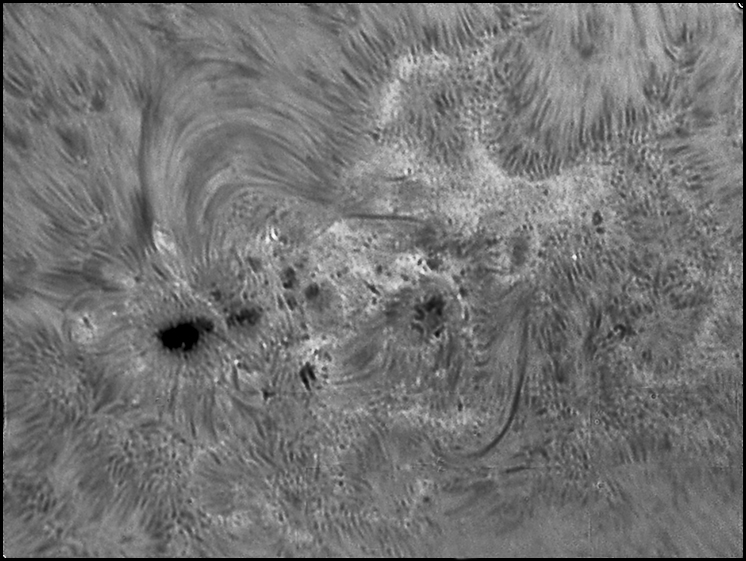|
"View Image" for slightly larger presentation.
Four panels, each the best 150 of 1000 frames. ZWO Optical ASI120MM, Teleskop-Services Tilt Adjuster Orion barlow (on snout for maximum EFL) FireCapture 2.2. Exp: 20ms / Gamma: minimum / Gain 18 Flatfielded using a defocused image of a relatively featureless area of the Sun (100 frames) Stacked in AVIStack 2, assembled in Photoshop, heavy lifting in PixInsight (deconvolution, mostly)
So I think that answers what to do about Newton's Rings (tilt the sensor, see previous page) and how to manage the dust accumulation on the sensor (clean it, but use a flat, too). A couple of mechanical refinements helped today: I made a tube from ProtoStar flocking paper and lined the inside of the 1.25-inch adapter to plug light leaks (the aluminum foil and electrical tape are still in place — why not?). And the results of this session were so gratifying that I was newly impressed by the importance of being able to tweak the focus remotely. To that end, I put the Feathertouch focuser back on the Lunt/Orion Frankenscope. The OEM focuser often balks at "in" travel with the weight of the camera, tilt adjuster and cabling in place, which is irritating when standing beside the telescope and really irritating when sitting inside. People in the know seem to think an M-class flare is inevitable from these ARs, and no one would admit being surprised by an X-flare. I watched several small flares come and go — there are several "sparks" in that picture above. Nothing reached even C-class while I had the spot in view. This was the best flare I caught all day; it came late in the afternoon, not long before evening shadows ended the session:
Same tech bits, single clip, best 100 of 1,000 frames.
7/08/2013. I installed the latest (2.3 Beta) version of FireCapture since it offered some significant upgrades for the ZWO camera. Then I tried some 16-bit captures. On the upside, these are more versatile in that I can control gamma during post; tones looks better; and they show less noise (presumably because I can use less gain when not fighting against the low gamma settings I use in 8-bit mode). But capture speed in fps is cut in half; the SER files are twice the size of AVI's of the same frame count; and SER files can't be easily previewed when triaging the day's catch. Even so, I'll likely adopt 16-bit for future captures. In practice either out by the 'scope or sitting here managing it remotely, it's easy to switch from 16-bit to 8-bit at minimum gamma for focusing and back again for imaging. AVIStack 2.0 takes the SERs without drama, and PixInsight works very well against the stacked output. I don't have anything today that will show much advantage to the 16-bit workflow, but at least I can demonstrate that it works:
Best 150 frames of 1000
Later that same day: I've discovered Ken Crawford's solar imaging tutorials. Much to learn there! Even applying (crudely) some of the tools he deploys, I've produced better color-coded H-a images than ever before. Stay tuned for those and (probably) for some much improved monochrome post processing, too.
:: top ::
|
© 2013, David Cortner


